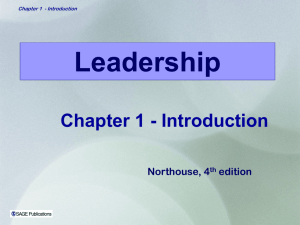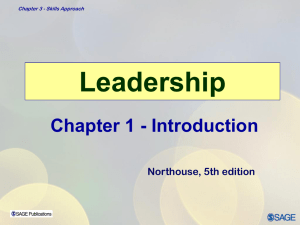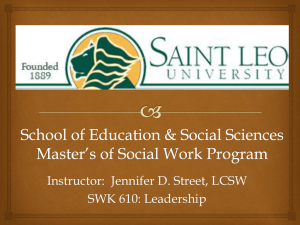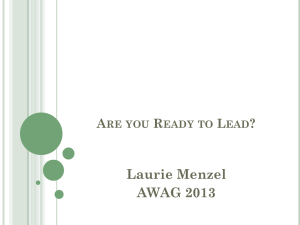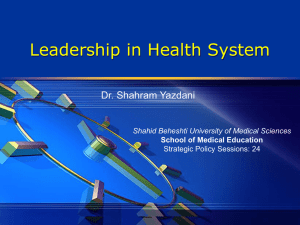Leadership (BUS426)
advertisement
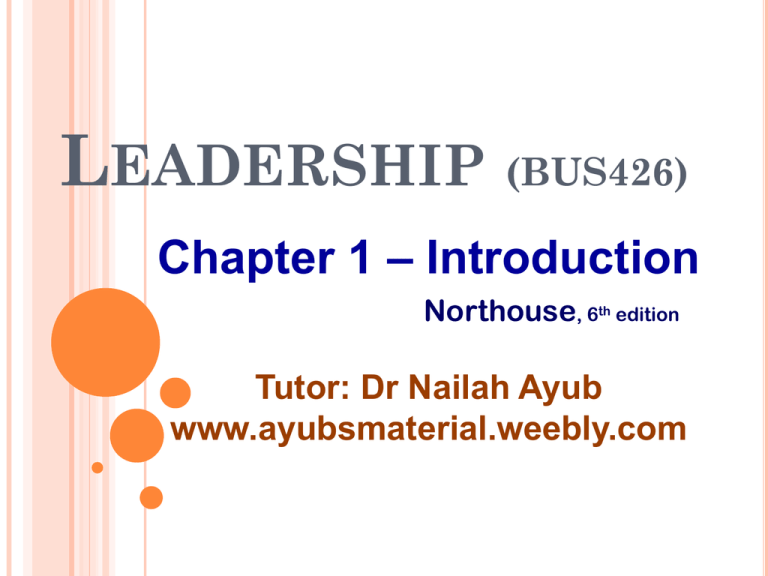
LEADERSHIP (BUS426) Chapter 1 – Introduction Northouse, 6th edition Tutor: Dr Nailah Ayub www.ayubsmaterial.weebly.com WHAT IS LEADERSHIP? Individuals: A way to improve personal, social, and professional lives Corporations: Leaders bring special assets to their organizations Academia: Leadership studies RESEARCH ON LEADERSHIP Leadership is a trait, a behavior, informationprocessing, or relational process Use qualitative and quantitative methods Many contexts: small groups, therapeutic groups, large organizations 200 different definitions for leadership between 1900-1990 Conclusion: Leadership is a complex process having multiple dimensions 1900-1929 Emphasized control and centralization of power A common theme of domination Defined: the ability to impress the will of the leader on those led and induce obedience, respect, loyalty, and cooperation 1930S Focus on traits Influence rather than domination Leadership is the interaction of an individual’s specific personality traits with those of a group While attitudes and activities of many are changed, the many also influence the leader 1940S Group Approach Leadership is the behavior of an individual while involved in directing group activities Persuasion, not ‘drivership’ 1950S Three themes Group theory continues: Leadership is what leaders do Leadership is a relationship that develops shared goals: defined on the basis of leader behavior Effectiveness: Leadership is the ability to influence overall group effectiveness 1960S Leadership as behavior continues Leadership is ‘acts by persons which influence other persons in a shared direction’ 1970S Organizational Behavior Approach: Leadership is ‘initiating and maintaining groups or organizations to accomplish group or organizational goals’ “Leadership is the reciprocal process of mobilizing by persons with certain motives and values, various economic, political, and other resources, in a context of competition and conflict, in order to realize goals independently or mutually held by both leaders and followers.” 1980S Focus: Nature of leadership Themes Do as the leader wishes Influence (non-coercive) Traits Transformation (Leadership is when one or more persons engage with others in such a way that leaders and followers raise one another to high levels of motivation and morality) 1990S- INTO THE 21ST CENTURY Debate over leadership versus management CONCEPTUALIZING LEADERSHIP 65 different classification systems in 60 years Some definitions view leadership as: The focus of group processes A personality perspective An act or behavior In terms of the power relationship between leaders & followers An instrument of goal achievement A skills perspective LEADERSHIP DEFINED Leadership is a process whereby an individual influences a group of individuals to achieve a common goal. COMPONENTS CENTRAL TO THE PHENOMENON OF LEADERSHIP Leadership Is a process Involves influence Occurs within a group context Involves goal attainment Leaders Are not above followers Are not better than followers Rather, an interactive relationship with followers 1: IS A PROCESS Not a trait that resides within the leader A transactional event between the leader and the followers Leader is also affected by the followers Not a linear, one-way events but an interactive event Not restricted to the formally designated leader in a group, but is available to everyone 2: INVOLVES INFLUENCE Concerned with HOW the leader affects followers 3: OCCURS IN GROUPS Groups are the context influence group of individuals who have a common purpose Of any size: small task group, a community group, large group or an entire organization 4: ATTENDS COMMON GOALS Achieve something together Have a mutual purpose Ethical overtone: need to work with the followers Although leaders and followers are closely linked Leaders initiate the relationship Create the communication linkage Carry the burden of maintaining the relationship Ethical responsibility to attend to the needs of the followers LEADERSHIP Trait vs. Process Leadership Assigned vs. Emergent Leadership Leadership & Power Leadership & Coercion Leadership & Management TRAIT VS. PROCESS LEADERSHIP Trait definition of leadership: Certain individuals have special innate or inborn characteristics or qualities that differentiate them from non-leaders. Leadership is a property or set of properties possessed in varying degrees by different people. Resides in select people Restricted to those with inborn talent LEADER Leadership • Height • Intelligence • Extroversion • Fluency • Other Traits FOLLOWERS TRAIT VS. PROCESS LEADERSHIP The process definition of Leadership: Leadership is a phenomenon that resides in the context of the interaction between leaders and followers and makes leadership available to everyone Observed in leadership behaviors Can be learned LEADER Leadership (Interaction) FOLLOWERS ASSIGNED VS. EMERGENT LEADERSHIP Assigned Leadership based on occupying a position within an organization Team leaders Plant managers Department heads Directors Emergent how group members respond to someone An individual perceived by others as the most influential member of a group or organization regardless of the individual’s title Not always the ‘real’ leaders Emerges over time through communication behaviors Verbal involvement Being informed Seek other’s opinions Being firm but not rigid LEADERSHIP & POWER Bases of Social Power French & Raven (1959) Power The capacity or potential to influence. Ability to affect others’ beliefs, attitudes & actions Power is a relational concern for both leaders and followers. Referent Expert Legitimate Reward Coercive LEADERSHIP & POWER Five Bases of Power LEADERSHIP & POWER Types and Bases of Power Position Power Power derived from office or rank in an organization Legitimate Reward Coercive Personal Power Power is influence derived from being seen as likable & knowledgeable Referent Expert LEADERSHIP & COERCION Coercion Involves Use of force to effect change (against will) Influencing others to do something via manipulation of rewards and penalties in the work environment Use of threats, punishments, & negative rewards LEADERSHIP & MANAGEMENT KOTTER (1990) Management Activities “Produces order and consistency” Leadership Activities “Produces change and movement” • Planning & Budgeting • Establishing direction • Organizing & Staffing • Aligning people • Controlling & Problem Solving • Motivating / Inspiring Major activities of management & leadership are played out differently; BUT, both are essential for an organization to prosper. LEADERSHIP & MANAGEMENT KOTTER (1990) Major activities of management and leadership are played out differently; BUT, both are essential for an organization to prosper. LEADERSHIP & MANAGEMENT Managers Leaders Unidirectional Authority Multidirectional Influence • Are reactive • Prefer to work with people on problem solving • Low emotional involvement • Are emotionally active & involved • Shape ideas over responding to them • Act to expand available options • Change the way people think about what is possible
